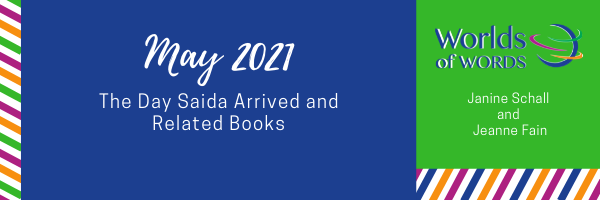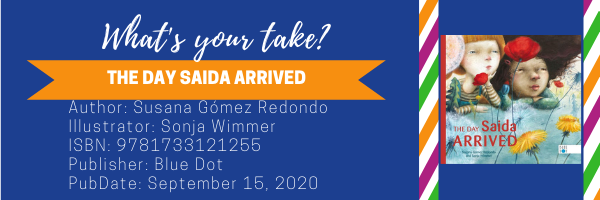Janine Schall, University of Texas Rio Grande Valley, Edinburg, TX, and Jeanne Fain, Lipscomb University, Nashville, TN
This month in My Take/Your Take, Janine Schall and Jeanne Fain focus their discussions on the book The Day Saida Arrived by Susana Gómez Redondo and Sonja Wimmer, translated from the original Spanish by Lawrence Schimel. Along the way we’ll mention related books. In this first installment, Janine and Jeanne talk about the use of Arabic within the text.
JANINE: The Day Saida Arrived is a gorgeous picture book about a young girl who befriends an Arabic-speaking newcomer named Saida to her school and community. The young girl, who narrates the story, is concerned because Saida “has lost all her words” and is sad. The two girls embark on a friendship where they teach each other their home languages—English for the narrator and Arabic for Saida. Jeanne, you were the first person who shared this book with me. I remember you said that you really appreciated the use of Arabic within the text because you work with kids who speak Arabic and their language is so rarely represented in children’s literature.
JEANNE: There are very few books that highlight children speaking Arabic in the picture book context. I think that there is a need for more picture books that use Arabic in meaningful ways. Saida includes the Arabic alphabet at the end of the book, which I appreciated. In my experience, when I ask children who speak Arabic what an Arabic word means in English, they often will not tell me which makes so much sense because they know I am an outsider to the Arabic language.
JANINE: That’s really interesting. I wonder if it’s because there’s so much anti-Arab and anti-Islamic prejudice in the world that Arabic-speaking kids get really protective of their culture and language and don’t want to share it with outsiders? Maybe books like The Day Saida Arrived, which incorporate Arabic throughout the text, could help make these children feel more comfortable and open conversations. Of course, books like this also help monolingual children learn about language and see that speaking more than one language is valued. And in particular—Arabic. I live in a part of the country that is highly Spanish/English bilingual and so when people in my area talk about bilingualism we often really mean Spanish/English bilingualism, forgetting that there are so many people in the U.S. who speak other languages. There are many ways to be bilingual.
I loved the way English and Arabic were incorporated into the illustrations in Saida.
JEANNE: I especially like that the narrator unpacks her experience with language learning, like when she describes the feeling of her tongue and how it’s a challenge to roll R’s. Throughout the illustrations you see English words, followed by a pronunciation guide and then the word in Arabic. I love seeing Arabic on the page but I would really prefer that publishers use the Arabic first. I think that when publishers place Arabic second in a text that they are sending a message to the reader that Arabic actually has a lesser place in the story and in the greater context of privilege. However, when I ask some students about this, they say that it doesn’t matter to them, that they attend to the language that they care about.
JANINE: That’s a good example of kids making strategic reading choices based on what matters to them.
Do you know of other children’s picture books that use Arabic? I can only think of a few others, such as the recent The Arabic Quilt: An Immigrant Story by Aya Khalil. I enjoyed that book very much, though I thought it got a little heavy-handed towards the end.
JEANNE: I love Stepping Stones: A Refugee Family’s Journey by Margriet Ruurs, which is a bilingual Arabic/English picture book. The story is powerful and the illustrations are stunning.
JANINE: Mirror by Jeannie Baker is also in Arabic and English. It’s a little older and I have really mixed feelings about it. I love the book design and that it’s bilingual. But it’s one of those books that compares two different locations/cultures to show how underneath it all we’re the same. Like many of those books, the dominant culture is depicted as urban and technologically advanced while the other culture is depicted in less favorable ways. Mirror compares life in a large Australian city with life in a small village in Morocco. Why wasn’t the comparison with a large city in Morocco?
JEANNE: There is Arabic strategically placed on the signs in the story Hands Around the Library: Protecting Egypt’s Treasured Books by Susan L. Roth and Karen Leggett Abouraya.
JANINE: Surely there are others.
JEANNE: Readers, we would love for you to join our conversation. Do you know of any high-quality children’s books that uses Arabic meaningfully? Tell us the title and what you appreciate about it.
Other Children’s Literature Cited
Khalil, A. (2020). The Arabic quilt: An immigrant story. Tilbury House
Ruurs, M. (2016). Stepping stones: A refugee family’s journey. Orca Book Publishers.
Baker, J. (2010). Mirror. Candlewick Press.
Abouraya, K. L. (2012). Hands around the library: Protecting Egypt’s treasured books. Dial Books.
Title: The Day Saida Arrived
Author: Susana Gómez Redondo
Illustrator: Sonja Wimmer
Translator: Lawrence Schimel
ISBN: 978-1733121255
Publisher: Blue Dot
PubDate: 2020 (English edition)
Throughout May 2021, Janine Schall and Jeanne Fain discuss different aspects of The Day Saida Arrived. Check back each Wednesday to follow the conversation!
- Themes: Day Saida Arrived, Janine Schall, Jeanne Fain, Lawrence Schimel, Sonja Wimmer, Susana Gómez Redondo
- Descriptors: Books & Resources, My Take/Your Take


